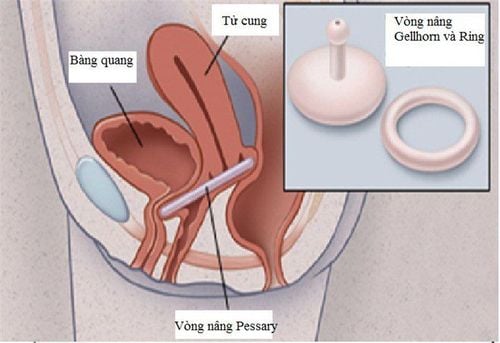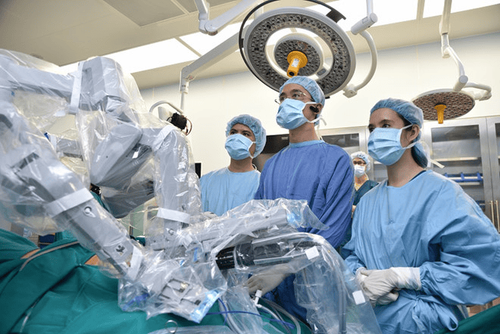This is an automatically translated article.
The article was professionally consulted by Doctor Nguyen Chi Quang - Vinmec Central Park International General HospitalGenital prolapse is a fairly common disease in Vietnamese women, especially women who work hard, give birth a lot, give birth unsafely in the age group of 40-50 years and older. Women who have not given birth can also have genital prolapse, but it is less common, and only the cervix is prolapsed.
1. The concept of genital prolapse
Genital prolapse is a phenomenon in which the uterus drops down into the vagina or completely outside the vulva, often accompanied by prolapse of the anterior vaginal wall and bladder or the posterior wall of the vagina and rectum.
Although it is not a life-threatening disease, genital prolapse greatly affects women's activities and work. But the patients are often resigned, hiding the disease because of this difficult disease, so they have to face many difficulties in life, especially trouble in the husband and wife relationship.
2. Causes of genital prolapse

Pregnancy : Multiple births, thick births, unsafe births, incorrect technique, perineal tear without stitches. Excessive labor: Working too hard or too soon after giving birth causes abdominal pressure to increase when the organs are still weak and have not returned to normal. Nutritional disorders: Common in people with chronic diseases, malnutrition, and the elderly. Geography: In addition, due to congenital anomalies in women who have never given birth, in women there are changes in the anatomy and function of the genital organs. These cases are usually simple cervical prolapse.
3. Symptoms of genital prolapse
The symptoms seen by the patient depend on the degree of prolapse, the time of the prolapse, the time of the prolapse, the simple prolapse or the combination of lesions, including: genitalia. Heaviness in the lower abdomen, entanglement and discomfort in the vulva - perineal area, affecting the patient's work and daily activities. Symptoms of urinary disorders (due to prolapse of the bladder and urethra): Difficulty in urination, painful urination, urinary incontinence, hematuria, urinary retention. Disturbances of bowel movements (due to rectal prolapse): Difficulty defecation, constipation, patients often have a feeling of straining, heaviness in the anal area. Bleeding, fluid from the cervix due to cervical inflammation, rubbing. Genital prolapse in young people can still be pregnant but is more likely to have a miscarriage or premature delivery.
4. Treatment methods for genital prolapse

Medical treatment
Indicated subjects:
In patients who are old and weak, have chronic diseases, have no surgical conditions. Daily hygiene, limited labor, can use traditional medicine but the results are not as expected. There are 3 possibilities:
Rehabilitation, especially in the perineum: Instruction of contraction exercises to restore the levator muscles in the perineal area. This method can relieve functional symptoms and delay surgery time. If surgery is required, restoring pelvic muscle tone also reduces postoperative recurrence. Intra-vaginal lifting ring: few indications today. Estrogen (ovestin, colpotrophine): Sometimes works well for some cases with functional symptoms such as bladder pain, painful intercourse, and is good for preparing for surgery. Surgical treatment
Is the main method in the treatment of genital prolapse. There are many surgical methods for genital prolapse. The purpose of surgery is to restore the uterine support system, lift the bladder, rebuild the anterior and posterior vaginal walls, suture the levator anal muscle, and reconstruct the perineum. Genitourinary surgery is performed primarily by the vaginal route rather than by the abdominal route. In addition to a simple hysterectomy, it also reconstructs the vaginal walls, so surgery in genital prolapse is also cosmetic. This is the main advantage that abdominal surgery cannot perform.
Factors related to the choice of surgical method:
Age and fertility after surgery. Sexual ability. General condition of the patient. Degree of genital prolapse. There are many surgical methods for genital prolapse. But there are three commonly used methods:

One, Manchester Method:
Indicated mainly for women who are young, want to have children and have second degree. This surgery is also applicable to elderly patients with grade III genital prolapse who cannot tolerate major surgery.
Major surgical steps:
Cervical amputation. Short suture of Mackenrodt's ligament. Bladder lift. Redo the previous one. Cervical restoration with Sturmdorft shots. Rebuild the posterior wall of the vagina. Two, Crossen surgery method:
Indications: grade III genital prolapse. Like the Manchester surgery, the Crossen surgery is performed only when the cervix is not inflamed. Complete hysterectomy vaginally. Cross tie the Mackenrodt ligaments with the other round ligament to suspend the sutures together into a strong hammock against intestinal prolapse. Bladder lift. Redo the previous one. Sew the muscles of the anus, redo the posterior wall of the vagina. Third, the Lefort method:
This is a simple method applied to the elderly, no longer having sexual relations, and the vagina and cervix are not infected. Technique: suturing the vagina. Alternatively, one can just redo the anterior vaginal wall, lift the bladder, or redo the posterior vaginal wall and lift the rectum. If this method is used in women who still have a uterus, it is necessary to leave two small grooves in the vagina to drain the uterine fluid. If the whole suture is closed, it can cause an abscess of the uterus and pelvis.
Over time, if not treated, it will become more and more prolapse, the degree of prolapse is fast or slow depending on age and how heavy or light the work is. In addition, there may be a number of associated complications.
Vinmec International General Hospital implements Crossen technique to treat genital prolapse with modern and complete equipment, the success rate is more than 99%. The advantage when performing Crossen surgery at Vinmec is that there is no incision on the abdomen, the patients after surgery are satisfied with the technique.
Patients will receive surgery from experienced, highly specialized obstetricians and a team of professional medical staff.
Please dial HOTLINE for more information or register for an appointment HERE. Download MyVinmec app to make appointments faster and to manage your bookings easily.














